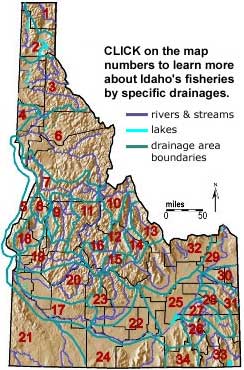Although all
of Idaho lies west of the continental divide, not all of its waters drain westward
to the Pacific Ocean. A portion of southeast Idaho drains into Bear Lake, which
is one of the largest interior drainage systems in the United States. In addition
there are a number of isolated drainages in eastern Idaho that do not flow into
the Snake or Bear Rivers that we term independent drainages. These include the
Lost Rivers and Birch, Medicine Lodge, Beaver, and Camas Creeks.
The remainder
of the state's surface drainage flows into the Columbia River. We have divided
this system, from north to south, into the Kootenai, Pend Oreille, Spokane (Coeur
d'Alene and St. Joe River systems), and the Palouse drainages. The Snake River
and its tributaries drain areas upstream and downstream of Shoshone Falls. The
major tributaries of the Snake River drainage below the falls include Salmon
Falls Creek, and the Wood, Bruneau, Owyhee, Boise, Payette, Weiser, Salmon,
and Clearwater Rivers. The Snake River above Shoshone Falls is comprised of
the North Fork (Henry's Fork) and the South Fork. Major tributaries are the
Teton, Blackfoot, and Portneuf Rivers.
The major
natural lakes of Idaho include Priest and Pend Oreille (Pend Oreille drainage),
Coeur d'Alene (Spokane drainage), Payette (Payette drainage, Snake River below
Shoshone Falls), Gray's (Snake River above Shoshone Falls), Mud (independent
drainage) and Bear (Bear River drainage). A large number of reservoirs have
been formed on Idaho's rivers. The major ones include Dworshak (North Fork Clearwater
River), Granite, Hells Canyon, Oxbow and Brownlee (Snake River, behind dams
of the same name), Cascade (North Fork of the Payette River), Arrow Rock and
Anderson Ranch, (Boise River), C. J. Strike (Snake River below Shoshone Falls),
Blackfoot (Blackfoot River), Palisades (South Fork of the Snake River), and
Island Park (Henry's Fork of the Snake River).
The Sawtooth
Lakes include a number of high mountain lakes in the Sawtooth Mountains near
the headwaters of the Salmon River. Numerous other smaller lakes and reservoirs
dot Idaho's landscape.
The geological
history of Idaho's drainages is not completely understood. Lava flows have changed
the courses of many streams. Later the effects of glaciation formed both temporary
and more permanent lakes. Glacial melting caused tremendous floods by breaching
temporary dams and resulted in the alteration of river courses. Abandoned stream
channels and dry waterfalls constitute evidence of these catastrophic events.
These and other past geological phenomena have had a profound impact on the
distribution of native Idaho fishes.
In the southern
part of the state, the development of Shoshone Falls was a major influence on
the past distribution of Idaho fishes and remains an effective barrier to the
present dispersal of these aquatic vertebrates. The falls were formed by unequal
erosion of the very resistant bedrock materials which form the crest of the
falls. This resistant rock mass may have become effective as early as 2-3 million
years ago. The result of this barrier to fish distribution was to prevent any
species of fish from extending its range upstream above the falls after its
formation. Any species arriving on the Idaho scene after this time, such as
the Pacific salmon and steelhead trout, were unable to penetrate the Snake River
drainage above the falls. Any fishes found in the Snake drainage above the falls
likely occupied this area before the formation of the falls or extended their
range to the Snake drainage from the Great Basin or from east of the Continental
Divide.
The Snake
River at one time (probably prior to the Pleistocene) flowed down the middle
of the Snake River Plain near the southern part of the U.S. Atomic Energy Commission
Reservation (north of its present course). Subsequent downwarping and lava flows
pushed the Snake River southeastward to its present course. Further uplifting
and a rise of crustal divides along with deposition of large quantities of rock
debris at the present southern reaches of the several drainage systems isolated
the Lost Rivers and the other independent drainages of the area. These streams
now flow generally in a southerly direction and sink into the permeable underground
materials, including volcanic deposits, along the northern edge of the Snake
River plain.
At a later
time during the Pleistocene the immense inland Pluvial Lake
Bonneville rose and overflowed into the upper Snake River through Red Rock
Pass south of Pocatello, Bannock County. The first overflow occurred about 14,500
years ago. This great flood scoured out channels and water falls. After the
flood the Bonneville Basin and the Snake River system were connected for a few
thousand years until the lake fell below the Provo shoreline at 4800 feet.
A number of fishes from the Lake Bonneville fauna entered the upper Snake River
in this manner. The present-day remnant of Pluvial Lake Bonneville is the Great
Salt Lake.
In Northern
Idaho during the Pleistocene, an ice lobe blocked the ancestral Clark Fork River
and formed Glacial Lake Missoula, a huge lake that occupied much of the Clark
Fork Valley all the way to Missoula, Montana. Recent estimates are that
forty separate times the ice dam formed by a valley glacier just east of Clark
Fork, Idaho, broke, and huge floods occurred. The waters swept across eastern
Washington toward the southwest and formed such features as Palouse Falls, the
channeled scablands of eastern Washington, and Spokane Falls. These falls formed
barriers to the post-glacial dispersal of fishes from the lower Columbia River,
such as the Pacific salmon and steelhead trout. Falls on the Pend Oreille and
Kootenai Rivers acted as similar barriers.
During glacial times many
other river drainages probably have exchanged waters. The end result of past geological
events is the present drainage patterns throughout the state. The current natural
distribution of Idaho's fishes is closely related to the geologic history and
associated phenomena of the past.
